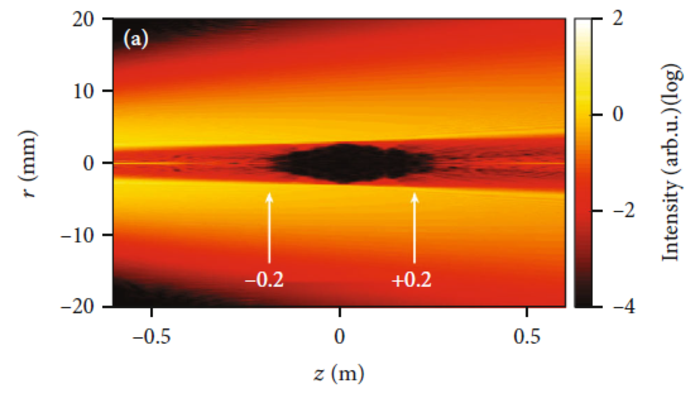Attosecond pulses are essential tools for time-resolved studies of electron dynamics on their natural time scale: attoseconds (10−18 seconds). Coincidence spectroscopy and experiments with high expectations on statistics or signal-to-noise ratio, particularly in the case of solid and molecular samples in chemistry and biology, are examples of these studies, which are all gaining popularity.
 The propagation of an annular beam in space. The highlighted region indicates where a mirror should be placed to efficiently separate the attosecond pulses from the generating laser beam. Image Credit: Ultrafast Science.
The propagation of an annular beam in space. The highlighted region indicates where a mirror should be placed to efficiently separate the attosecond pulses from the generating laser beam. Image Credit: Ultrafast Science.
Researchers need to expand the number of attosecond pulses in a given unit of time for these cutting-edge research topics, which can only be done by increasing the attosecond source’s repetition rate.
A laser source with high average power and high repetition rate is required for this. However, in comparison to traditional attosecond beamlines using lower power drivers, the high average power of the driving laser source poses a challenge: it is difficult to separate the attosecond pulses from the high-average-power laser beam after generation.
To solve this problem, researchers at the Extreme Light Infrastructure Attosecond Pulse Light Source (ELI ALPS) shaped the laser beam into an annular shape, which they combined with proper experiment configuration to produce the highest attosecond-pulse-train energy per shot produced by a system with a repetition rate above 10 kHz.
Dr. Peng Ye and his co-workers used one of ELI ALPS’ HR-GHHG beam lines to achieve these results in a project overseen by Dr. Balázs Major and Prof. Katalin Varjú. While J. Peatross put forth the idea of producing high-order harmonics using an annular beam in 1994, and Y. Mairesse used it to produce attosecond pulses with low-power lasers in 2003, scaling this concept to high average had many challenges that had to be overcome.
The main challenge is that when a laser with high average power is used, the propagation of the laser pulse through free space and the ionized generation medium must be considered carefully. Researchers at ELI ALPS modified this method for high average power systems, resulting in the highest transmission of attosecond pulses from the generation point to the target position ever achieved.
The method is based on the strong field effect that occurs during the high harmonic generation process. The focused, annular laser beam propagates to a Gaussian-like solid spot, where attosecond pulses are generated, and then propagate further to a perfect annular beam.
Highly nonlinear effects occur in this light-matter interaction as a result of the laser pulse’s strong electric field, and the shape of the produced attosecond beam varies from the laser beam shape.
This allows it to be spatially separated from the driving laser. Free propagation was also used by ELI ALPS scientists to shape the probe beam to be annular, allowing it to be combined with attosecond pulses with minimal loss. As a result, the high energies of both the attosecond pulses and the probe laser beam can benefit pump-probe experiments.
Many experiments that require both a high repetition rate and enough energy can now be performed in ELI ALPS thanks to the 100 kHz high-energy attosecond pulse-train source that has been achieved.
Journal Reference:
Ye, P., et al. (2022) High-Flux 100 kHz Attosecond Pulse Source Driven by a High-Average Power Annular Laser Beam. Ultrafast Science. doi.org/10.34133/2022/9823783.